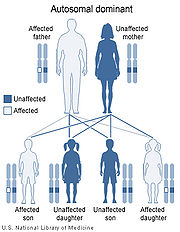
Tietz syndrome
Encyclopedia
Tietz syndrome, also called Tietz albinism-deafness syndrome or albinism and deafness of Tietz, is an autosomal
dominant congenital disorder
characterized by deafness and leucism. It is caused by a mutation in the microphthalmia-associated transcription factor
(MITF) gene. Tietz syndrome was first described in 1923.
 Tietz syndrome is caused by mutations in the MITF
Tietz syndrome is caused by mutations in the MITF
gene, located on human chromosome
3p14.1-p12.3
. It is inherited in an autosomal dominant manner. This indicates that the defective gene responsible for a disorder is located on an autosome
(chromosome 3 is an autosome), and only one copy of the defective gene is sufficient to cause the disorder, when inherited from a parent who has the disorder.
Autosome
An autosome is a chromosome that is not a sex chromosome, or allosome; that is to say, there is an equal number of copies of the chromosome in males and females. For example, in humans, there are 22 pairs of autosomes. In addition to autosomes, there are sex chromosomes, to be specific: X and Y...
dominant congenital disorder
Congenital disorder
A congenital disorder, or congenital disease, is a condition existing at birth and often before birth, or that develops during the first month of life , regardless of causation...
characterized by deafness and leucism. It is caused by a mutation in the microphthalmia-associated transcription factor
Microphthalmia-associated transcription factor
Microphthalmia-associated transcription factor is a basic helix-loop-helix leucine zipper transcription factor involved in melanocyte and osteoclast development.-Clinical significance:...
(MITF) gene. Tietz syndrome was first described in 1923.
Cause and Genetics

Microphthalmia-associated transcription factor
Microphthalmia-associated transcription factor is a basic helix-loop-helix leucine zipper transcription factor involved in melanocyte and osteoclast development.-Clinical significance:...
gene, located on human chromosome
Chromosome
A chromosome is an organized structure of DNA and protein found in cells. It is a single piece of coiled DNA containing many genes, regulatory elements and other nucleotide sequences. Chromosomes also contain DNA-bound proteins, which serve to package the DNA and control its functions.Chromosomes...
3p14.1-p12.3
Chromosome 3 (human)
Chromosome 3 is one of the 23 pairs of chromosomes in humans. People normally have two copies of this chromosome. Chromosome 3 spans almost 200 million base pairs and represents about 6.5 percent of the total DNA in cells....
. It is inherited in an autosomal dominant manner. This indicates that the defective gene responsible for a disorder is located on an autosome
Autosome
An autosome is a chromosome that is not a sex chromosome, or allosome; that is to say, there is an equal number of copies of the chromosome in males and females. For example, in humans, there are 22 pairs of autosomes. In addition to autosomes, there are sex chromosomes, to be specific: X and Y...
(chromosome 3 is an autosome), and only one copy of the defective gene is sufficient to cause the disorder, when inherited from a parent who has the disorder.

